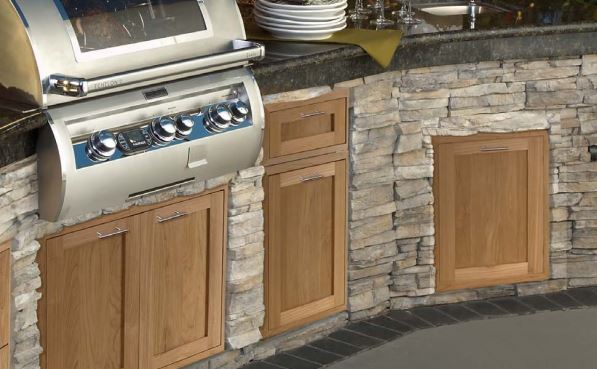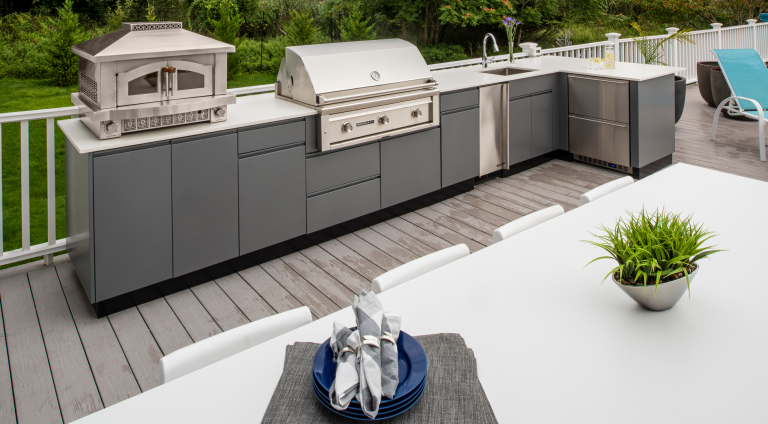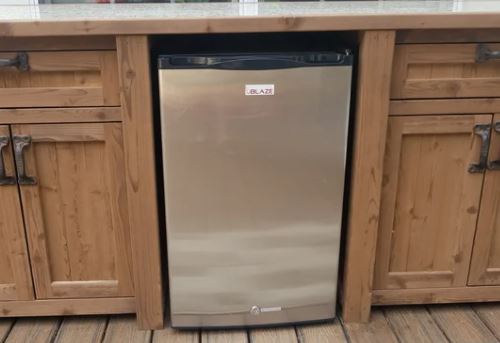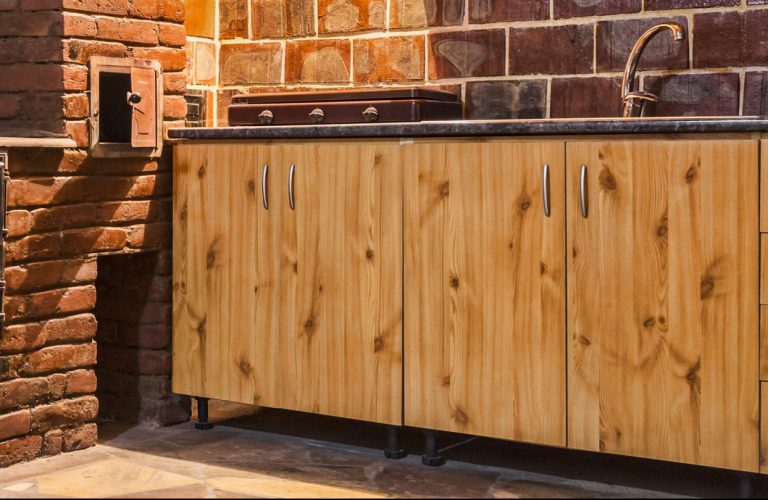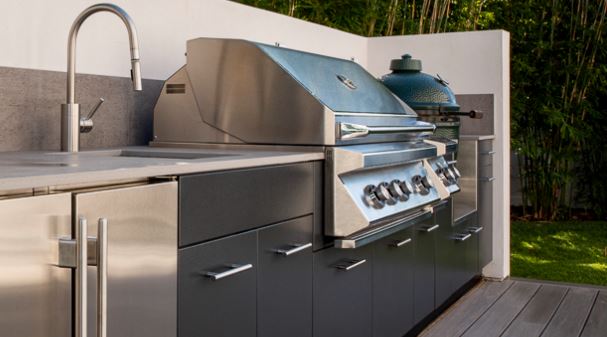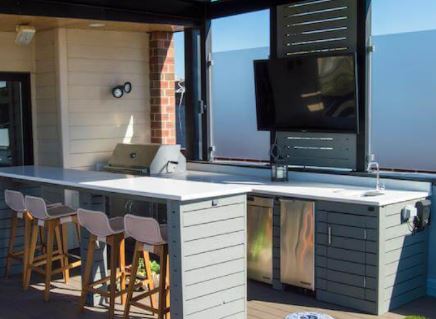Weatherproof Outdoor Cabinets
Choosing Weatherproof Outdoor Cabinets for Your Outdoor Kitchen
An outdoor kitchen is a great way to set up shop in your backyard for entertaining and serving hungry guests. Outdoor kitchens can range in size from small spaces with just a built-in barbeque grill to enormous, fully equipped kitchens with multiple grills, counters, sinks, bars, and storage cabinets. They can be one of the most used home improvement you can make.
When designing an outside space, consider how many people you’ll be hosting, your entertaining requirements, your need for outdoor storage, and your budget. The next step is to choose the optimal location for your kitchen, as well as the appropriate size, design layout, countertop placement, and appliances. Finally, you must select the ideal resources and tools to achieve all of your objectives including weather resistance.
And that step will require that you make a choice in weatherproof outdoor cabinetry to start your build.
Weatherproof outdoor cabinets differ from other outdoor storage option such as deck boxes and storage sheds because of their intended use. Cabinets are intended to be used frequently and must hold up to the demands placed on them just as indoor kitchen cabinets do. They are not just storage space to organize your tools, but can also serve as a prep table or potting bench in your outdoor garden.
How to Choose the Right Weatherproof Outdoor Cabinetry
The questions you need to ask when deciding between different outdoor cabinet options are:
1. What level of Water Resistance do cabinets have?
Of course the cabinets you choose should be weatherproof for your location and climate. But they also need to be waterproof.
You need the cabinets to be able to safely store such things as utensils, paper goods, pots and grill pans. Any and all of these items will get ruined over time if water is allowed to accumulate inside and soak the contents of cabinets and drawers.
If the cabinets are waterproof, they will also effectively seal against dust, pollen and infiltration of grilling smoke and pollutants. This is typically not an issue with indoor cabinets, but very much an issue with outdoor ones. You don’t want to have to clean all your cooking accessories before each use because they have gotten dirty while stored inside an outdoor cabinet or drawer in between grilling sessions.
2. How durable and strong are the cabinets?
Weatherproof cabinets should stand up to not only wind and rain, but hail, sleet and snow if your climate experiences these. They should not become dented or marred under normal use. They also need to be able to support heavy weight countertops such as concrete and granite.
A outdoor cabinet should be able to safely store heavy items such as propane tanks or cast iron pans. This means the cabinet boxes should be sturdy enough to support one or more shelves with heavy objects without buckling under the weight.
Similarly, outdoor grill cabinets and cabinets that hold ceramic grills need to be substantial enough and engineered properly to support the weight of these large appliances.
Some folks use their outdoor cabinetry for deck storage. Patio furniture outdoor cushions, and other garden storage items can be kept nearby safely enclosed in cabinetry to protect from sun damage and weather. Having spacious outdoor waterproof storage will help keep your backyard tidy and well organized.
3. Are they easy care or do they require a lot of maintenance?
The ideal outdoor cabinet will look good and last a long time without daily maintenance. Of course you will want to keep up with spills and grease spatter as they occur, but you don’t want to have to polish or deep clean your cabinets regularly. Your outdoor kitchen will just become another chore.
Choosing low maintenance materials for your outdoor kitchen means more time for cooking and grilling and less time making the kitchen look presentable to friends and more sanitary for prepping food.
4. Will they marry well with my home’s building materials and architecture?
Ignoring a home’s architectural style is one of the mistakes people make when building an outdoor kitchen or bar. Your cabinet selection should reflect the style and period of your home and use similar building materials to make a visual connection between the home and the outdoor cooking space.
There are ways that you can do a good job of blending cabinet styles with modern outdoor cooking amenities. For example, if you have a vintage Spanish style stucco home with a clay tile roof, then you can build your base cabinetry with stucco and add stainless steel access doors and drawers to the build. The result will be a modern outdoor kitchen with a nod to the architecture of your home.
What Types of Materials are Weatherproof Outdoor Cabinets Made Of?
You can purchase pre-assembled outdoor kitchen units made of HDPE (high density polyethylene), stainless steel, and outdoor-friendly wood species such as teak and ipe. All can be fabricated into waterproof outdoor cabinetry.
Built in place cabinetry can be made of any weather resistant outdoor material such as wood, stucco, bricks and stone. These cabinets start out with an aluminum or wood frame box outdoor. The frame is covered with a substrate, usually cement board, and then the finish surface is applied over the substrate. These types of cabinets are very popular DIY projects and will require cabinet doors and drawer fronts for access to the storage cabinets’ interior.
Care and Maintenance of Weatherproof Outdoor Cabinets
One of the hallmarks of a good outdoor cabinet is that it should not require much maintenance.
Using stainless steel hinges in construction will ensure that these won’t become rusted over time and need replacing or rust removal so they work properly.
Stainless Steel Care and Cleaning
To keep your stainless steel cabinets in good shape and prevent corrosion, keep them clean and free of food and other debris.
The following are some helpful cleaning hints for stainless steel:
• Use only alkaline, alkaline-chlorinated, or non-chloride cleaners on your stainless steel
• Avoid hydrochloric acid (muriatic acid) on your stainless steel
• Always use a non-abrasive cleaning tool like a soft cloth or plastic scouring pad
• Avoid steel pads, wire brushes, and scrapers
• Always clean in the direction of the polishing marks by locating the lines or grain and scrubbing in a motion parallel to them If you do use a chlorinated cleaner, make sure to rinse it well and dry it as soon as possible.
• Allow your equipment to air dry.
Powder Coated Stainless Steel Care
• Use a soft, non-abrasive cloth or rag, clean water, and a neutral washing agent (pH 7).
• Avoid using abrasive materials.
• Do not use alkaline or strong acid cleaners.
• Avoid using detergents with unknown ingredients.
• If the surface temperature of the powder-coated cabinets is higher than 77°F (25°C), do not clean them.
• Do not leave powder-coated cabinets exposed to detergents or cleansers for more than one hour.
• After each cleaning, immediately rinse the powder coating with cold water.
• Lotions, oils, and creams can have a negative impact on powder coating finishes. If the powder coating is exposed to hazardous oils, it should be cleaned as soon as possible.
• Severe soiling can be tackled using a neutral or weak alkaline detergent.
• Use isopropyl alcohol to remove grease, oil, soot, adhesive residues, and silicone.
• Avoid using solvents or comparable substances that contain ester, ketones, polyhydric alcohol, aromatics, ethylene glycol, or halogenated hydrocarbons.
HDPE Cabinetry Care
As needed, wash the exterior of the HPDE cabinetry with water and a soft cloth or sponge. If the storage item cabinetry is exceptionally filthy, use a mild detergent to wash the exterior, much as you would a car. If necessary, a soft bristle brush can be used to remove dirt.
To avoid water marks, dry the cabinetry with a soft towel or chamois.
Wipe the cabinetry with a microfiber cloth and a vinyl protectant such as Armor-All on a regular basis to improve the appearance.
Scrape or scrub the cabinetry using abrasive materials to avoid permanently damaging the surface.
The cabinetry should not be painted or stained.
Pool chemicals (such as chlorine tablets, liquid chlorine, acid, and so on) will not harm the cabinetry, but the vapors from these chemicals may eventually harm the hinges. Apply a stainless steel protectant or silicone spray to the hinges on a regular basis to prevent damage.
Teak Wood Cabinetry Care
One of the most appealing characteristics of high-quality teak wood is how little maintenance it requires and how elegantly it ages. This is true of each style teak wood cabinet, whether louvered double doors or solid panel wooden storage access doors.
Teak’s color changes over time, from golden honey to a silver-grey patina that characterizes finely aged, outdoor teak. If left untreated, the silver-grey patina will turn a darker greenish-grey over time.
If you like the natural hue of aged solid wood teak, all you have to do is clean it on a regular basis. In most circumstances, a good rinse with a garden hose once or twice a month and a wipe off with a towel is sufficient.
If you prefer the golden tone of fresh teak, more frequent cleanings will keep the color as close to its original as possible. Teak wood used for outdoor storage can also be treated with a teak sealer or protection. This will not shorten the wood’s life, but it will keep the golden honey tone that so many people enjoy.
Cleaning and re-oiling starts a maintenance plan that includes cleaning and re-oiling every 3 months to a year. Another approach is to sand the outdoor cabinetry wood’s very outside surface lightly.
New wood with a golden tone will be exposed as a result of this. Regular cleanings are necessary to prevent impurities from building on your cabinets, which can create an environment conducive to the growth of mold or fungus on the wood’s surface. Clean any small black stains that appear on the wood’s surface as soon as possible.
A simple scrub of teak outdoor wooden storage with a teak cleaner or mild dish soap and clean water, followed by a towel or soft, nylon bristle brush, is all that is required in tougher settings or when cleaning has been ignored.
Related Articles About Outdoor Kitchen Cabinets
16 Things to Think About When Building Cabinets for an Outdoor Kitchen

